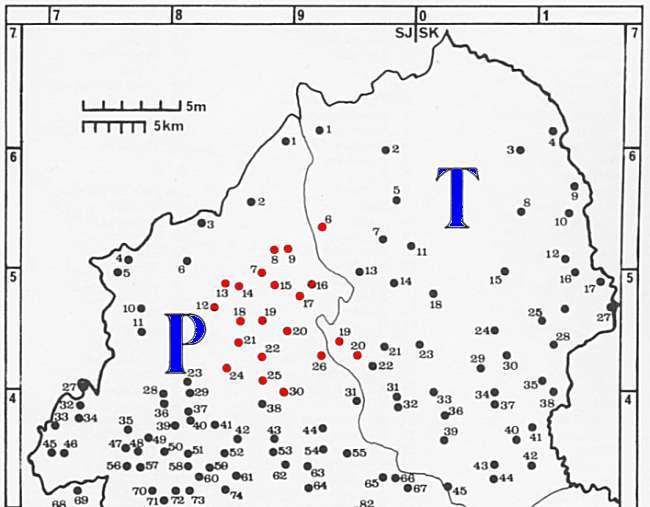| The Pirehill and Totmonslow Hundred & Stoke-on-Trent | |
The Pirehill and Totmonslow Hundred & Stoke-on-Trent
relevant links: The Domesday Book | Trade Journals and Gazetteers
Hundreds
The Hundreds were districts with within a shire (county), whose assembly of notables and village representatives met for administrative purposes. These date back to the formation of the county as an administrative unit around the early 10th century in the reign of Edward the Elder.
The Hundred courts levied taxes, dealt with law and order matters, and tried some civil and criminal offences. The functions of the Hundreds were gradually taken over by other local government organisations, although they retained some powers into the 19th century.
Staffordshire was divided into five Hundreds: Cuttlestone; Offlow; Pirehill; Seisdon and Totmonslow.
The area of Stoke-on-Trent falls almost exclusively into the north part of Pirehill Hundred with Weston Coney and Caverswall being in the west of Totmonslow Hundred.
Pirehill and Totmonslow Hundred
The area of Stoke-on-Trent falls almost exclusively into the north part of

From William White's trade gazetteer of 1851 "History, Gazetteer and Directory of Staffordshire," we get the following descriptions of the Pirehill and Totmonslow hundreds.
Pirehill Hundred
"Pirehill, one of the most populous and largest of the five Hundreds of Staffordshire, is as remarkable for the fertility of its soil, for the beauty and diversity of its scenery, and the number and beauty of its seats of nobility and gentry, as it is for the extent and importance of its manufactures of earthenware and china, in the long chain of towns and villages called the Potteries, and of shoes at Stafford and Stone.
It is about 28 miles in length, and from 8 to 15 in breadth, and is bounded on the north-east by Totmonslow, on the east by Offlow, on the south by Cuttlestone Hundred, and on the west and north-west by Shropshire and Cheshire.
The River Trent rises at its northern extremity, and flows through it in a south-easterly direction, passing the noble seats of Trentham, Ingestre, Shugborough, and Wolseley, and nearly parallel with that river runs the Trent & Mersey Canal, which has branches to Stafford, Newcastle, etc.
This large Hundred is also traversed by the North Staffordshire and the Grand Junction (or Birmingham & Liverpool) Railways, which have several branches.
It includes the boroughs of Stoke-upon-Trent and Newcastle-under-Lyme, and part of Stafford, and is divided into 43 parishes, which comprise about 150 townships, liberties and hamlets, and many chapelries or district parishes. Besides Stoke, Stafford and Newcastle, it has seven other market towns, Burslem, Tunstall, Hanley & Shelton, Longton, Stone, Eccleshall, and Abbot's Bromley.
It is divided into North and South Divisions, and is all in the Northern Parliamentary Division of Staffordshire, in the Diocese of Lichfield, Archdeaconry of Stafford, and Deaneries of Newcastle and Stone.
Its population has increased rapidly during the last half century, from 64,946 in 1801, to over 150,000 in 1851. The great bulk of this augmentation has occurred in the three parishes of Burslem, Stoke-upon-Trent, and Wolstanton, which include the Potteries."
[From History, Gazetteer and Directory of Staffordshire, William White, Sheffield, 1851]
Totmonslow Hundred
"Totmonslow, or Totmanslow, is the north-eastern Hundred of Staffordshire, and contains that mountainous region called the Moorlands, which adjoins and partakes of the general character of the Derbyshire Peak, abounding in lime, coal and stone.
This bleak and alpine district exhibits many of the wildest and most stupendous features of nature, as well as some of her more chaste and fertile beauties, the latter of which are confined chiefly to the narrow and picturesque valleys of the rivers Dove, Manyfold, Hamps, Tean, Blythe, Dane, and Churnet, which have their principal sources in this Hundred, and here receive many small but rapid streams from the high, peaty moorlands and rocky mountains which rise in picturesque disorder, and shut in the fertile pastures of the glens and valleys.
The Hundred is of irregular, oval figure, stretching from the three shires stone, above Flash, southwards to Uttoxeter, a distance of 25 miles, and averaging from 10 to 15 miles in breadth. The River Dove forms its eastern boundary for nearly 30 miles, and separates it from Derbyshire, and from about 10 miles at its northern extremity, it is divided from Cheshire by the River Dane.
The southern and eastern parts of it are traversed by the Uttoxeter and Caldon Canals, and by the Churnet Valley and North Staffordshire Railways.
It contains four market towns, Leek, Longnor, Cheadle, and Uttoxeter, and about 70 townships, comprised in ten chapelries and thirty parishes. They are divided into North and South Divisions, and Mr William Keats, of Leek, is the High Constable of the former, and Mr J Kidney, of Uttoxeter, of the latter. The whole Hundred is in the Northern Parliamentary Division of Staffordshire, and in the Rural Deaneries of Alstonfield, Cheadle, Leek, and Uttoxeter."
[From History, Gazetteer and Directory of Staffordshire, William White, Sheffield, 1851]
relevant links: The Domesday Book | Trade Journals and Gazetteers
|
|
| questions/comments/contributions?: email: Steve Birks |